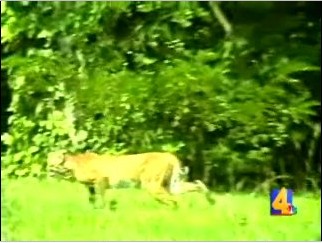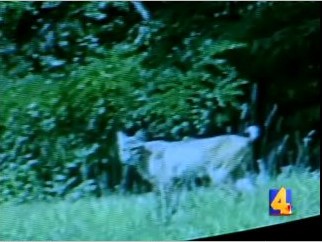
January 6, 2007
Nashville Cats, play clean as country water
Nashville Cats, play wild as mountain dew
Nashville Cats, been playin’ since they’s babies
Nashville Cats, get work before they’re two
— by John B. Sebastian, Lovin’ Spoonful, 1967.

Is this cryptid black cat a melanistic bobcat (Lynx rufus/Felis rufus)?
Back on November 19, 2006, I wrote about the sightings and then videotape of a large short-tailed cat seen in Nashville, Tennessee. Speculations covered caracal, lynx, and bobcat.
The two images below are from the video taken of the Tennessee Mystery Cat:


Ben Willis of Bigcats.org brings to my attention that a road-killed 44 pound bobcat (see below) was found along a major highway near Camp Lejeune, North Carolina. The specimen, Willis feels, closely resembles the cat videographed at Nashville.


In a new article about bobcats, posted by Chad Arment on his Strange Ark research list, some confusing statements are shared by the author Frank Sargeant. Sargeant says that despite his hearing from people in Florida that they are seeing a "panther," he thinks they are seeing bobcats. He comments:
Bobcats are nowhere near the size of panthers; they weigh only about 25 pounds, typically, compared to 80 to 120 pounds for a panther. They’re only about three feet long, while the panther’s tail is that length. The bobcat is named for its "bobbed" tail, which is only about 6 inches long. And they wear black spots over a tawny brown to tan coat.
Panthers are a solid brown or tan, with no spots. And they are not black, period. Many of the calls I get describe "black panthers," but the biologists say it just is not a possibility. There has never been a single valid incidence of a black panther in Florida, nor in the general cougar population of North America….
Frank Sargeant concluded:
If you see a big black critter in the woods, it’s probably a Labrador retriever – or maybe a wild hog.
But what Sargeant ignores is a well-known existing population of black bobcats, one of which may be represented in the photograph taken in Florida (above). This animal was caught on film recently by a university professor from Georgia and shared with me by Ben Willis. It is posted at the top of this blog. If it is a melanistic bobcat, it would be a Lynx rufus floridanus (a/k/a Felis rufus floridanus)
Stanley P. Young’s 1958 bible on the animal, The Bobcat of North America documents the Southern pockets of black bobcats and has a photograph of one of them in captivity.
In 1978, I saw a black bobcat crossing a road near the edge of the Everglades National Park, while I was doing fieldwork on the Skunk Ape. Sometimes when you go looking for one thing, you can be rewarded with other remarkable experiences.
About Loren Coleman
Loren Coleman is one of the world’s leading cryptozoologists, some say “the” leading living cryptozoologist. Certainly, he is acknowledged as the current living American researcher and writer who has most popularized cryptozoology in the late 20th and early 21st centuries.
Starting his fieldwork and investigations in 1960, after traveling and trekking extensively in pursuit of cryptozoological mysteries, Coleman began writing to share his experiences in 1969. An honorary member of Ivan T. Sanderson’s Society for the Investigation of the Unexplained in the 1970s, Coleman has been bestowed with similar honorary memberships of the North Idaho College Cryptozoology Club in 1983, and in subsequent years, that of the British Columbia Scientific Cryptozoology Club, CryptoSafari International, and other international organizations. He was also a Life Member and Benefactor of the International Society of Cryptozoology (now-defunct).
Loren Coleman’s daily blog, as a member of the Cryptomundo Team, served as an ongoing avenue of communication for the ever-growing body of cryptozoo news from 2005 through 2013. He returned as an infrequent contributor beginning Halloween week of 2015.
Coleman is the founder in 2003, and current director of the International Cryptozoology Museum in Portland, Maine.
Filed under Alien Big Cats, Breaking News, Cryptomundo Exclusive, Cryptotourism, CryptoZoo News, Cryptozoologists, Cryptozoology, Evidence, Eyewitness Accounts, Forensic Science, Mystery Cats, Out of Place, Skunk Apes